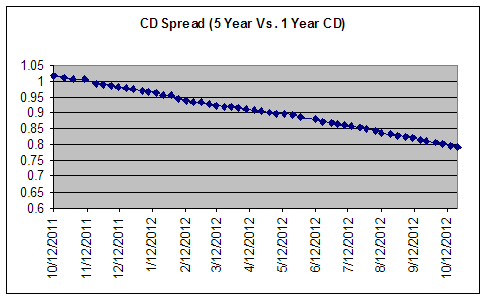It's been a slow week on the economic news and rate front as bankers head for the hills and take an extended vacation. When I worked at a bank, I remember that the week between Christmas and New Years was slow. The bank was manned by a skeletal crew and for the most part, no significant decisions were made.
On the economic front, the biggest news of the past week has been the steepening of the Treasury Yield Curve to record levels. The yield is considered by many to be the most important economic indicator. My economics teacher in business school harped on its importance. The curve plots the yields of Treasury bills, notes, and bonds. A steep yield curve indicates that short term rates are low and long term rates are higher. A steep yield curve is usually a sign of an impending economic recovery as investors anticipate growth and inflation and believe longer-term rates will go up as demand for capital growns. An inverted yield curve (short term rates are equal to or higher than long-term rates) is a strong sign of a recession, since investors are betting that growth, inflation, and rates are coming down in the future.
Over the last week we experienced the steepest yield curve on record. Usually this would be a strong signal of future growth but there is a wrinkle this time. Massive government borrowing may be distorting the yield curve. Since the government needs to borrow so much money, many investors are anticipating two things: 1) inflation as the government money fuels a recovery; 2) rising Treasury rates as the government has to provide a higher rate to convince investors to soak up so much Treasury demand.
The yield curve is important for savers for several reasons. First, it directly influences the rate you'll receive on money market funds and some longer-term CDs. Money market funds invest in Treasuries and other government and municipal bonds which often take their cue from Treasuries. Second, if you invest in Treasuries, the yield on different maturities is important. Third, it provides some indication of what's going to happen in the future. Right now, the steep yield curve is indicating that rates are going up.. So, as we've said before, it might not be the best time to lock up money in a long-term CD. In 12 months you might be able to get an even better rate. Lastly, Treasury securities serve as benchmarks which help to determine mortgage rates. It's no coincidence that record low yield in Treasuries correspond to record low mortgage rates. If Treasury yields go up, so will mortgage rates.
So, what we're glimpsing in the yield curve is the eventual increase in rates for savers (good news) and the increase in rates for borrowers (not good news).
CD and Savings Rates
As long as the Fed keeps its Fed Fund rate at 0-.25% we're not going to see any significant increase in savings and CD rates. While Treasuries can serve as a forward-looking indicator, savings and most CD rates are pegged to the Fed Funds rate and not from the Treasury bond market. Savings and CD rates continue their slow glide to oblivion, although as we mentioned, rates were pretty unchanged over the past Holiday week. Savings rates stayed steady at 1.57% APY. 1-year CD rates dropped by one basis point from 1.96% to 1.95% APY. This marks the second week in a row that both savings and 1-year CD rates have not dropped or hardly dropped. 3-year CD rate rose 1 basis point to 2.66^% APY and and 5-year rates continued their recent slide, down 3 basis points from 3.21% APY to 3.18% APY.

Like the Treasury yield, BestCashCow has developed its own yield ratio for deposit accounts - the spread between savings rates and 36-month CDs. In some ways, this ratio is purer because it cannot be influenced by government debt, Fed Treasury purchase programs, and other attempts to manipulate rates. As you can see below, the ratio between savings accounts (a short duration deposit account) and 3 year CDs has dropped slightly over the past three weeks. It's still at a very elevated level though, mimicking the Treasury curve. We'll be watching how the ratio develops over the next month to see if it provides any additional clues to the state of the market in 2010.
At this point it's still hard to recommend putting money into anything longer-term than a 12-month CD, especially with rising equity markets and signs that the economy may be coming back to life. Many depositors may be willing to lock money away for 5-years at close to 3%. To me that's just not enough of a return for that period of time. For those worried about interest rate risk, cd laddering may be a good way to smooth out the return you receive from your CD portfolio.
Mortgage Rates
According to Freddie Mac's weekly survey, 30 year mortgage rates rose by 11 basis points from 4.94% to 5.05%. It's the first time since October that the average 30-year mortgage rate has gone above 5%. Data from th BedsCashCow rate tables show that average mortgage rates on 30-year mortgages (the most popular mortgage taken) shot up from 4.95% to 5.193%. This mimics the increase we've seen in longer-term Treasuries. As the Fed ends its purchase of mortgage-backed securities and Treasury securities, we'll probably see rates continue to rise. From all indications, mortgage rates are going up, which is bad for homebuyers and the general housing market.
Frank Nothaft, a Freddie Mac Vice President had this to say about rates going above 5%. "Although interest rates for 30-year fixed-rate mortgages are above 5 percent this week for the first time since the end of October, they are still around 0.5 percentage points below this year’s peak set in mid-June. ARM rates increased by a lesser amount as the market consensus calls for no rate hikes by the Federal Reserve in the immediate future."
You can compare the best mortgage rates in our new mortgage section.












Add your Comment
use your Google account
or use your BestCashCow account